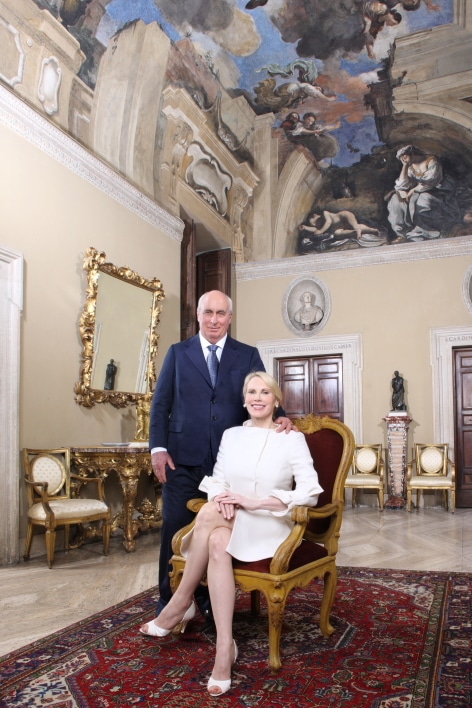The villa houses the only known ceiling painting by the Baroque artist Michelangelo Merisi da Caravaggio.
Texas-born Princess Rita Boncompani Ludovisi, the widow of Prince Nicolo Boncompani Ludovisi, has been evicted from a villa in Rome with a unique Caravaggio fresco over a long-running inheritance dispute, dpa and Reuters reported.
Italian carabinieri escorted Texas-born and raised Rita Boncompani Ludovisi, 73, from the villa that houses the only known ceiling painting by Baroque artist Michelangelo Merisi da Caravaggio (1571-1610). Half of the property is her property according to a will, and the other half – the late Prince Nicolo left to his sons from his first marriage. He died in 2018.
As part of the inheritance dispute, several failed attempts have been made to auction the historic building, called Aurora, for around €140 million, and now a court has ordered the villa to be vacated.
According to the sons of Prince Boncompani Ludovisi, the princess does not take care of the house properly and offers paid guided tours without permission.
One of the heirs of the late prince explained that the villa should be extensively renovated.
The villa was built in 1570 and has belonged to the Ludovizi family since the beginning of the 17th century. In 1597, Cardinal Del Monte, a diplomat and patron of the arts, commissioned Caravaggio, then in his early 20s, to paint the ceiling of a small room on the first floor, which he used as an alchemical laboratory. The 2.75 meter wide mural is painted in oil directly on the plaster and depicts an allegorical scene with the gods Jupiter, Neptune and Pluto representing the transmutation of lead into gold. Caravaggio painted his own face and body on each of the three figures.
The villa owes its name to a fresco by another Baroque artist, Guercino, which adorns the huge ceiling of the entrance hall and depicts Aurora, the goddess of the dawn, riding a chariot.














 English
English French
French Spanish
Spanish German
German Dutch
Dutch Italian
Italian Danish
Danish Portuguese
Portuguese Greek
Greek Russian
Russian Swedish
Swedish Bulgarian
Bulgarian Hungarian
Hungarian Catalan
Catalan Ukrainian
Ukrainian Polish
Polish Basque
Basque Chinese (Simplified)
Chinese (Simplified) Japanese
Japanese Hebrew
Hebrew Arabic
Arabic Swahili
Swahili Amharic
Amharic Irish
Irish Afrikaans
Afrikaans Albanian
Albanian Armenian
Armenian Azerbaijani
Azerbaijani Belarusian
Belarusian Bengali
Bengali Bosnian
Bosnian Cebuano
Cebuano Chichewa
Chichewa Chinese (Traditional)
Chinese (Traditional) Corsican
Corsican Croatian
Croatian Czech
Czech Esperanto
Esperanto Estonian
Estonian Filipino
Filipino Finnish
Finnish Frisian
Frisian Galician
Galician Georgian
Georgian Gujarati
Gujarati Haitian Creole
Haitian Creole Hausa
Hausa Hawaiian
Hawaiian Hindi
Hindi Hmong
Hmong Icelandic
Icelandic Igbo
Igbo Indonesian
Indonesian Javanese
Javanese Kannada
Kannada Kazakh
Kazakh Khmer
Khmer Korean
Korean Kurdish (Kurmanji)
Kurdish (Kurmanji) Kyrgyz
Kyrgyz Lao
Lao Latin
Latin Latvian
Latvian Lithuanian
Lithuanian Luxembourgish
Luxembourgish Macedonian
Macedonian Malagasy
Malagasy Malay
Malay Malayalam
Malayalam Maltese
Maltese Maori
Maori Marathi
Marathi Mongolian
Mongolian Myanmar (Burmese)
Myanmar (Burmese) Nepali
Nepali Norwegian
Norwegian Pashto
Pashto Persian
Persian Punjabi
Punjabi Romanian
Romanian Samoan
Samoan Scottish Gaelic
Scottish Gaelic Serbian
Serbian Sesotho
Sesotho Shona
Shona Sindhi
Sindhi Sinhala
Sinhala Slovak
Slovak Slovenian
Slovenian Somali
Somali Sundanese
Sundanese Tajik
Tajik Tamil
Tamil Telugu
Telugu Thai
Thai Turkish
Turkish Urdu
Urdu Uzbek
Uzbek Vietnamese
Vietnamese Welsh
Welsh Xhosa
Xhosa Yiddish
Yiddish Yoruba
Yoruba Zulu
Zulu